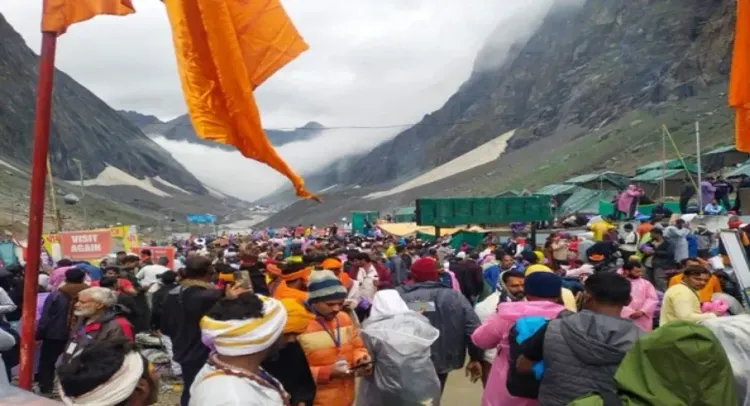How Many Have Undertaken the Amarnath Yatra in 21 Days?

Synopsis
Key Takeaways
- The Amarnath Yatra has seen over 352,000 pilgrims in just 21 days.
- Enhanced security measures are in place to protect devotees.
- The pilgrimage routes include traditional and shorter paths.
- Significant cultural and spiritual rituals accompany the Yatra.
- The journey concludes on August 9, marking important religious observances.
Srinagar, July 25 (NationPress) Over 352,000 devotees have participated in the ongoing Amarnath Yatra as another group of 2,896 pilgrims departed from Jammu to the Valley on Friday, according to officials.
Officials noted that the tally of Yatris partaking in the Shri Amarnath ji Yatra has surpassed the anticipated figure of 350,000 since the journey commenced on July 3.
A new batch of 2,896 Yatris departed from Bhagwati Nagar Yatri Niwas in Jammu in two escorted convoys heading to the two base camps.
The first convoy, consisting of 42 vehicles and carrying 790 Yatris, left at 3:30 a.m. for the Baltal base camp, while the second convoy with 75 vehicles transporting 2,106 Yatris departed at 4:18 a.m. for the Pahalgam base camp.
The 'Chhari Mubarak' (Holy Mace of Lord Shiva) was taken to the historic Shankaracharya Temple in Srinagar for a traditional Puja on Thursday, led by a group of Sadhus under the guidance of Mahant Deependra Giri.
This Puja at Shankaracharya Temple is an annual event coinciding with 'Haryali-Amavasya' (Shravan Amavasya) in accordance with ancient traditions.
On Friday, the Chhari Mubarak will proceed to the 'Sharika Bhawani' Temple situated on the Hari Parvat hill in Srinagar for customary rituals.
The Chhari Mubarak will embark on its final journey towards the cave shrine from the Dashnami Akhara temple in Srinagar on August 4, reaching the holy cave on August 9, which marks the official conclusion of the Yatra.
This year, authorities have implemented extensive multi-layered security measures for the Amarnath Yatra following the tragic attack on April 22 by Pakistan-backed terrorists that resulted in the death of 26 civilians in Pahalgam.
An additional 180 companies of Central Armed Police Forces have been deployed alongside the existing Army, BSF, CRPF, SSB, and local police.
The Army has dispatched over 8,000 special commandos to ensure the safety of pilgrims during this year's Yatra.
The pilgrimage began on July 3 and will last 38 days, concluding on August 9, coinciding with Shravan Purnima and Raksha Bandhan.
Devotees can access the holy cave shrine located 3,888 metres above sea level in the Kashmir Himalayas via the traditional Pahalgam route or the shorter Baltal route.
Those taking the Pahalgam route journey through Chandanwari, Sheshnag, and Panchtarni, covering a distance of 46 km on foot, which typically takes four days to complete.
Alternatively, those on the shorter Baltal route trek 14 km to the cave shrine and return to the base camp the same day after visiting.
Due to security concerns, no helicopter services are available for Yatris this year.
The cave shrine features an ice stalagmite structure that varies with the lunar phases.
Devotees believe this ice stalagmite symbolizes the mythical powers of Lord Shiva.








